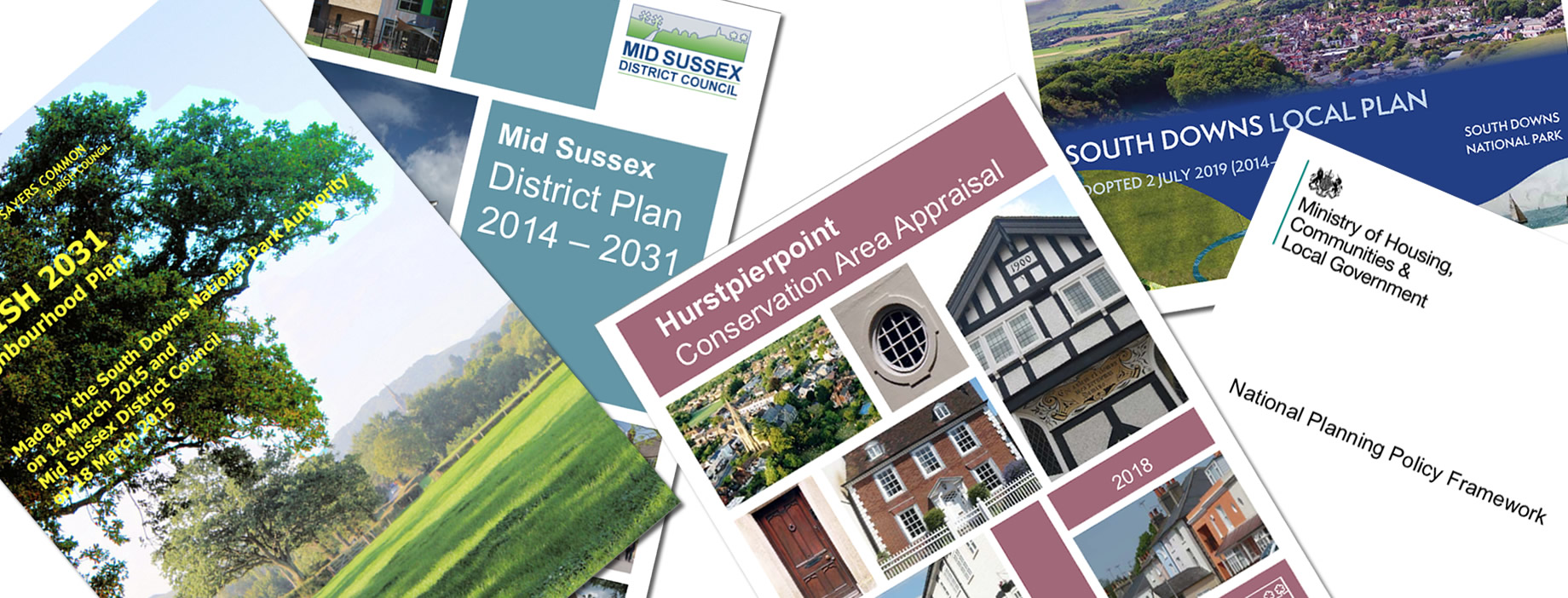The MSDC District Plan Review
To view MSDC’s documents related to The MSDC District Plan Review, click the image on the right. For the latest updates on The Society’s work regarding the current MSDC District Plan Review, CLICK HERE.
Members Guide to Local Planning
The National Planning Policy Framework (NPPF) provides the basis of national planning regulation. The Mid Sussex District Plan (MSDP) provides the main local policies that also apply to all planning here in Hurst. Also with large areas of our village inside and abutting the South Downs National Park (SDNP) the recently adopted the South Downs National Park Local Plan (SDNPLP), also carries relevant policy requirements.
The Localism Act allowed communities to develop their own planning policies to reflect local needs and aspirations.
The Neighbourhood Plan
The Neighbourhood Planning (General) Regulations 2012 (NPGR) came into effect on 6thApril 2012. Mid Sussex District Council (MSDC) is the Planning Authority for our Neighbourhood. Hurstpierpoint and Sayers Common Parish Council is the relevant designated body here. The designated area covers the same as the area within the Parish boundary.
Now forming part of the District Plan, the Neighbourhood Plan produced by the Parish Council (H&SC 2031 NP), in consultation with all interested parties, was subject to scrutiny by MSDC for legal compliance and conformity with national and local policies, and put out to consultation, amended, independently examined, successfully voted for by referendum, and was ‘made’ by the South Downs National Park Authority on 14thMarch 2015 and Mid Sussex District Council on 18thMarch 2015.
A further site allocation process is underway, although this mainly effects Sayers Common, not Hurst. We will keep you posted with relevant changes on our news page and facebook .
Hurst Society’s Contribution to Planning Regulation
Further to the above, Hurst Society was instrumental in the creation of Conservation Areas. The three Conservation Areas within the village are
- The Hurstpierpoint Conservation Area, centred around the High Street, designated in 1972 and extended in 1999;
- Langton Lane Conservation Area, situated to the west of the village centre and designated in 1999, and;
- Hurst Wickham Conservation Area, located to the east of the centre along College Lane and designated in 1989.
On 19thJuly 2018, after 10 years of deliberation, the latest changes to the 3 conservation areas in the High Street, Langton Lane and Hurst Wickham were designated by MSDC in the Hurstpierpoint Conservation Area Appraisal 2018 (HCAA2018). This appraisal contains detailed maps of the Conservation Areas.
In terms of planning, The HCAA 2018 considers what features make a positive or negative contribution to the significance of the conservation areas, thereby identifying opportunities for beneficial change, or the need for planning protection. The HCAA 2018 is a material consideration when determining planning applications.
It is important to be aware that the regulatory system does not protect the right to a view, however the ‘setting‘ of a listed building and conservation areas are protected.
Further Conservation material can be seen here.
To build or not to build
An important part of Hurstpierpoint Society’s work is to make an objective appraisal of planning applications and give our recommendations to both the Parish Council and Mid Sussex District Council.
As the village expands we are concerned that new development is integrated comfortably into this downland village rather than concentrated in large estates.
We have joined forces with other groups to fight against large scale development on various sites.
We continually examine and comment on planning applications with a view to meeting both aesthetic and social needs, and we monitor environmental issues. We also take note of all planning applications as they are submitted but if you are concerned about an application, please let the Society know. Again, we may post signifant developments or changes on our news page and facebook .
Mobile Masts
Hurst Society will campaign against the erection of mobile phone masts and their antennae in inappropriate places. While most of us have mobile phones, better use can be made of existing masts, both in the signals they provide, and what they look like.
Light Pollution
Light pollution is a concern and we support objections to this modern-day visual pollutant, and its effect on wildlife. The horizon to the north of Hurstpierpoint in the evenings is shrouded in an orange glow.
The simple pleasure of the night sky, unpolluted by artificial lighting, should be protected as a heritage for our children and beyond.

